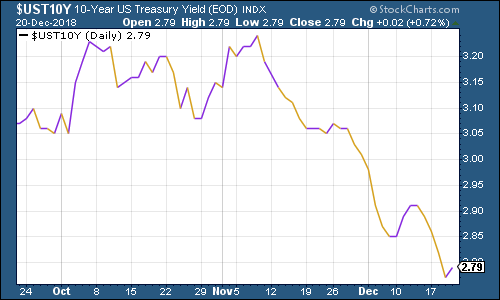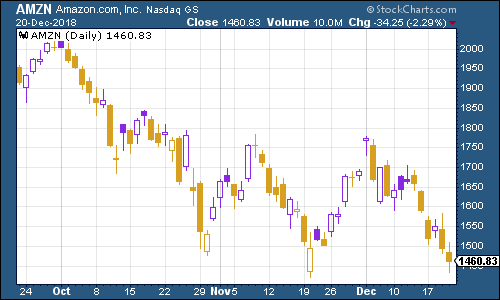The charts that matter: the Fed turns tough
For the last time this year, John Stepek casts his eye over the charts that matter most to the global economy.

Welcome back.
Do you tick the Gift Aid box when you give to charity? In this podcast, Merryn explains why you shouldn't. Listen to it if you don't already agree with her, I reckon you will by the time it's done.
And if you missed the podcast before that one, you can listen to our final pre-Christmas thoughts on Brexit and the cheapness of UK assets here.
MoneyWeek
Subscribe to MoneyWeek today and get your first six magazine issues absolutely FREE

Sign up to Money Morning
Don't miss the latest investment and personal finances news, market analysis, plus money-saving tips with our free twice-daily newsletter
Don't miss the latest investment and personal finances news, market analysis, plus money-saving tips with our free twice-daily newsletter
If you missed any of this week's Money Mornings, here are the links you need.
Monday: There's one key reason why markets have had such a rough 2018
Tuesday: How Amazon's secret weapon is wreaking havoc on Britain's retailers
Wednesday: How did my prophecies for 2018 pan out?
Thursday: Markets get a sinking feeling: maybe the "Powell put" doesn't exist
Friday: This was the most important event for markets in 2018
And don't miss this week's issue of MoneyWeek magazine which features a quite extraordinary number of share and fund tips. And sign up now If you're not already a subscriber, because we'll have even more tips in our final issue of the year, out on 28 December. Subscribe now!
And now... over to the charts.
First, the yield curve (here's a reminder of what it is). The chart shows the difference (the "spread") between what it costs the US government to borrow money over ten years rather than two. Once this number turns negative , the yield curve has inverted which almost always signals a recession (although perhaps not for up to two years).
Until it goes below zero, there's no signal. But we're mighty close.

(The gap between the yield on the ten-year US Treasury and that on the two-year: going back three months)
So how about gold (measured in dollar terms)? The yellow metal showed signs of breaking out this week as fear gripped markets. Concerns about the Fed raising interest rates have been over-ruled by investors in "flight to safety" mode.
Charlie Morris, who contributes to MoneyWeek regularly and also writes The Fleet Street Letter, recently got in touch to upgrade his gold outlook to "bullish" for the first time since 2012.
Charlie is good on gold he sees the point of gold, but he's not a full-on, permabull gold bug by any means. So when he says gold is looking promising, I do pay attention.

(Gold: three months)
The US dollar index a measure of the strength of the dollar against a basket of the currencies of its major trading partners showed signs of turning again amid fears of a US funding shutdown.
We've seen this before, and we also know that markets really aren't fond of shutdowns and anything that casts doubt on US creditworthiness (particularly given that the president is known for his rather lackadaisical attitude towards debt).
Yet at the same time, a weaker US dollar is what everyone will be hoping for to start 2019 on a better note than it appears 2018 will be ending.

(DXY: three months)
The ten-year US Treasury bond yield remained well below 3% as fears grow that the Fed will tighten too much and send the economy into recession.

(Ten-year US Treasury yield: three months)
The Japanese government bond (JGB) yield is close to zero again. The Bank of Japan indicated this week that it has no plans to tighten policy soon, and little wonder.

(Ten-year Japanese government bond yield: three months)
Ten-year German bund yields (the borrowing cost of Germany's government, Europe's "risk-free" rate) stayed flat along with US bonds.

(Ten-year bund yield: three months)
Copper is grinding slowly lower. I think we want to keep an eye on this because if Chinese monetary policy does loosen significantly I would expect to see it have an impact here first.

(Copper: three months)
I spoke too soon last week. It appears that we do have a Santa Claus rally for cryptocurrency bitcoin. There has been a turn in sentiment a high-profile story on Bloomberg about a trader who publicly shorted bitcoin deciding to exit the short popped up this week.
There's definitely a sense that if the cryptocurrency has any use at all, then this might be a buying opportunity. I even saw a recent comment from some generally sober-minded value investors that this looked like a good time to buy. At the same time, we've seen these sorts of rallies before.
I won't deny that I'm tempted once again to try to invest a little in the cryto sector now (but to be very clear, I am talking play money here a "getting to know you" investment that I can afford to lose rather than anything that would make a genuine difference to my portfolio).
And I'll tell you something else. I'm wondering if the price of bitcoin is linked to tight or loose Chinese monetary policy. Copper isn't reacting yet but any hint of China loosening might have helped put some money bitcoin's way. I'm not necessarily convinced but let's keep an eye on it this year.

(Bitcoin: ten days)
Now let's look at the four-week moving average of weekly US jobless claims. This week it dipped to 222,000, as weekly claims came in at 214,000. As David Rosenberg of Gluskin Sheff has noted, the stockmarket typically does not peak until after we've seen jobless claims (as measured by the four-week moving average) hit rock bottom for a cycle. On average, the peak follows about 14 weeks from the trough for jobless claims. A recession follows about a year later. (But remember that this is taken from a small sample size with a lot of variation).
Let's say we've already troughed in mid-to-late September. That would suggest that the stock market may already have peaked sure, it wouldn't fit in with the 14-week average, but as I say, that was a small sample size. In turn, that would imply a recession late next year or in 2020.
That doesn't sound unrealistic to me. That said, the data is particularly unreliable at this time of year, so I wouldn't write off a fresh trough yet (although equally, I suppose it could head a lot higher). If we have already hit the trough however, then I suppose we'll need to start looking for a good indicator that gives us an idea of when the market might rally once we know we're in a recession...

(US jobless claims, four-week moving average: since January 2016)
The oil price (as measured by Brent crude, the international/European benchmark) continues to struggle and this week it headed to fresh lows. I have been saying that a turnaround in the oil price would be a good sign for stocks similarly, a continued slide does not bode well for risk appetite.
Eventually, the fundamentals of supply and demand will assert themselves, but just now the market feels as though it's being driven mainly by fearful sentiment about global growth slowing.

(Brent crude oil: three months)
I use Amazon as a good indicator of sentiment in markets because it's a "no-brainer" stock. Professional investors have seen Amazon as being the stock that you won't get fired for owning for a long time now. So if Amazon is not being bought on the dips anymore, you know the market psychology has changed. And that certainly appears to be the case now.

(Amazon: three months)
Electric car group Tesla has finally stopped defying market gravity this week, taking quite a tumble. A Morgan Stanley analyst long considered one of the main Tesla bulls this week warned that the company could be about to hit a peak and that it should raise money to pay off debt. More generally, with the Fed showing its teeth, investors in "jam tomorrow" companies have been badly rattled.

(Tesla: three months)
Have a great weekend. There will be another Money Morning on Monday, but this will be the last Saturday morning roundup until 5 January.
Get the latest financial news, insights and expert analysis from our award-winning MoneyWeek team, to help you understand what really matters when it comes to your finances.
John Stepek is a senior reporter at Bloomberg News and a former editor of MoneyWeek magazine. He graduated from Strathclyde University with a degree in psychology in 1996 and has always been fascinated by the gap between the way the market works in theory and the way it works in practice, and by how our deep-rooted instincts work against our best interests as investors.
He started out in journalism by writing articles about the specific business challenges facing family firms. In 2003, he took a job on the finance desk of Teletext, where he spent two years covering the markets and breaking financial news.
His work has been published in Families in Business, Shares magazine, Spear's Magazine, The Sunday Times, and The Spectator among others. He has also appeared as an expert commentator on BBC Radio 4's Today programme, BBC Radio Scotland, Newsnight, Daily Politics and Bloomberg. His first book, on contrarian investing, The Sceptical Investor, was released in March 2019. You can follow John on Twitter at @john_stepek.
-
 The shape of yields to come
The shape of yields to comeCentral banks are likely to buy up short-term bonds to keep debt costs down for governments
-
 The sad decline of investment clubs – and what comes next
The sad decline of investment clubs – and what comes nextOpinion Financial regulation and rising costs are killing off investment clubs that once used to be an enjoyable hobby, says David Prosser
